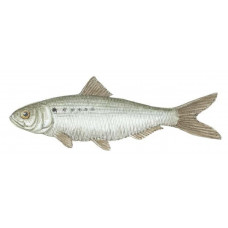Latin name
Alosa mediocris
Other names
Shad herring, hickory jack, freshwater taylor, fall herring, bonejack.
Identification
Gray-green on the back and transitioning to silver on the sides, the hickory shad has transparent fins, except for the dusky dorsal and caudal fins, which sometimes have black edging. It has a strongly sloped mouth, with the lower jaw visibly protruding beyond the upper jaw and a cheek longer than or about equal to its depth. There is a blue-black spot at the upper edge of the gill cover, followed by a cluster of indistinct dusky spots extending below the dorsal fin. There are also teeth on the lower jaw and 18 to 23 rake on the lower end of the first gill arch.
Distribution
Found only along the Atlantic coast of North America, the hickory shad extends from the Kenduskeag River, Maine, to the St. John's River, Florida. It is most common in the Southeast and Mid-Atlantic regions. This species overlaps with American shad and rises in some of the same rivers during spawning.
Habitat
The Hickory shad is a schooling species that spends most of its life in the ocean. When it becomes mature, it returns in early spring and summer to rivers and streams to spawn, dwelling in the open water of medium and large rivers. Juveniles descend into rivers in the fall.
Size
It can reach nearly 2 feet in length and weigh an average of 1 to 3 pounds. Can weigh up to 6 pounds.
Life history and Behavior
The sexually mature individuals mature at 2 years of age and are about 12 inches long. Adults ascend into coastal rivers in the spring. The preferred water temperature ranges from 55° to 69 °F.
Food and feeding habits
In the sea, hickory shad feed on small fish as well as squid, small crabs, other crustaceans, and fish roe. Anglers do not catch them where they feed, but catch them when they migrate upriver.
Reproduction
The female lays up to 300,000 eggs. The young remain in rivers, estuaries, and floodwaters, migrating to the sea in the fall or early winter.
| Classification | |
| Phylum | Chordata |
| Class | Actinopterygii |
| Squad | Clupeiformes |
| Family | Clupeidae |
| Genus | Alosa |
| Species | A. mediocris |
| Features | |
| Conservation status | Least Concern |
| Habitat | Pelagic |
| Life span, years | 10 |
| Maximum body weight, kg | 0.5 |
| Maximum length, cm | 37 |
| Sailing speed, m/s | No information |
| Threat to people | Edible |
| Way of eating | Planktonophage |


